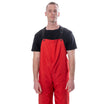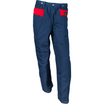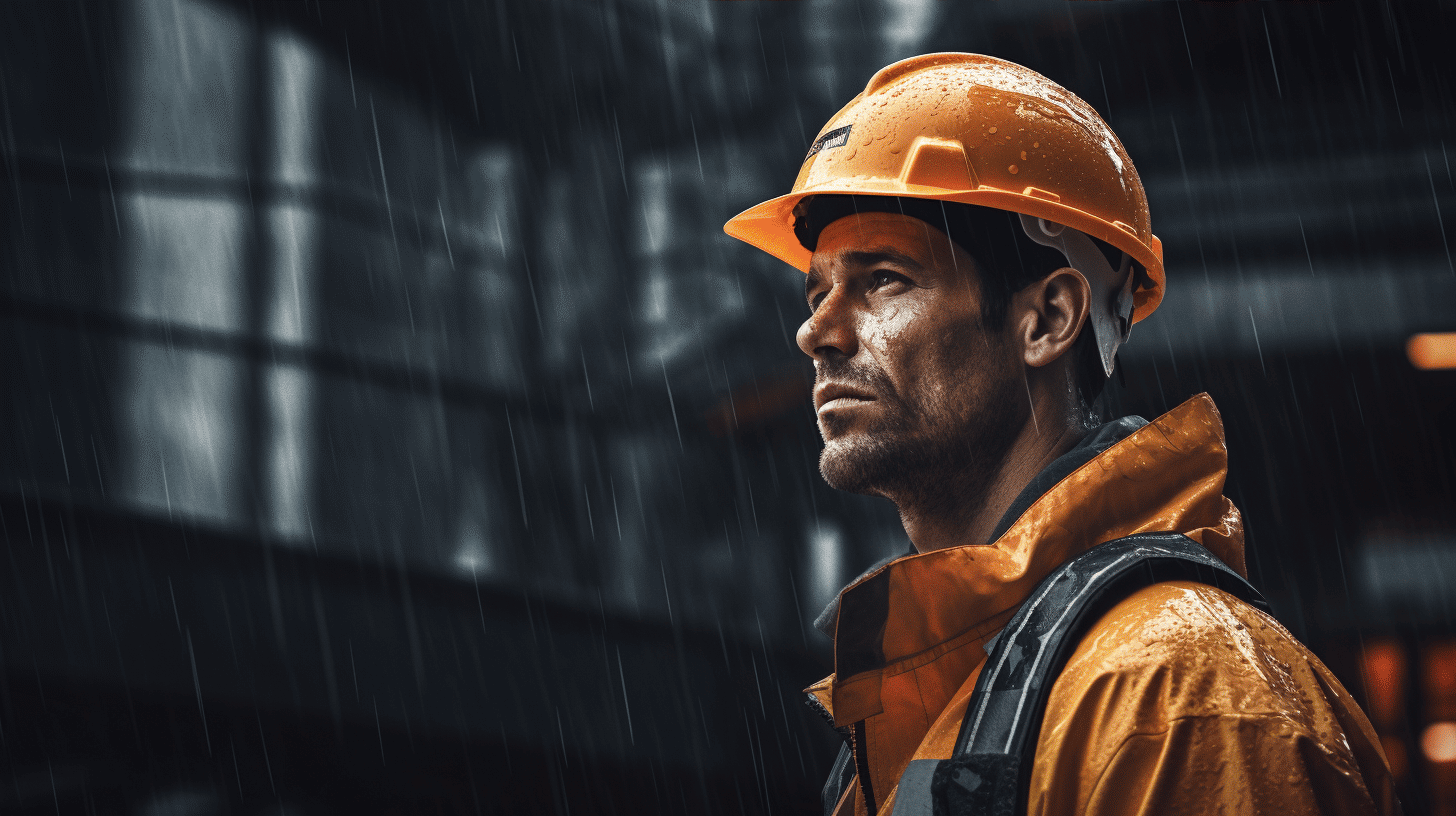Welcome, dear reader! We're about to embark on an intriguing journey that delves into the evolution of rain gear in the construction industry. A seemingly straightforward topic, it surprisingly intertwines many areas including technology, safety, productivity, and environment. Known for its tough nature, the construction industry remains disparagingly vulnerable to climate inclemency. It might be the brute strength of a thunderstorm or the nagging drizzle represented by a stubborn rain, both causing work to halt, deadlines to lapse and, unsurprisingly, employees to suffer.
It's here that rain gear steps in, the silent hero doing its share of work, shielding construction workers from the harsh weather elements, and ensuring the wheel of productivity keeps turning. Over the ages, rain gear has witnessed a radical transformation, from the humble raincoat to tech-loaded attire. So, buckle up as we take you through a fascinating exploration of how rain gear in construction has morphed over time, the technological marvels on the horizon, the challenges it faces, and what the future potentially holds for it. Don't worry about bringing an umbrella; we've got you covered!
The Need for Rain Gear in the Construction Industry
When encountering inclement weather, construction workers indeed face quite the challenge. Torrents of rain not only dampen the day but can create hazardous working conditions that significantly impact the otherwise smooth camaraderie of construction disciplines. Good construction managers appreciate the importance of adequate rain gear—it's not only about keeping the crew dry and comfortable but also about ensuring safety and productivity during adverse weather conditions.
The Impacts of Weather Conditions
Adverse weather like heavy rains can really throw a wrench into the gears of construction operations. And while sunny days are ideal for getting work done, it's impractical to expect perfect weather each day. In the event of rainfall, construction sites can quickly turn into slippery, hazardous terrains posing numerous challenges:
- Increased danger of slips and falls due to wet surfaces and obscured view.
- Shortage of grip on tools, potentially leading to accidental material damage or personal injury.
- A decrease in morale, productivity, and efficiency due to discomfort, cold, and physical exertion.
The Role of Rain Gear for Safety and Productivity
Proper rain gear in the construction industry is more than just a protective measure—it's an investment in safety and productivity. Suited up in water-resistant clothing, workers are better prepared to handle the added risks that rain brings.
- Safety: High-quality rain gear minimizes the risk of accidents by providing better traction and insulation against the cold. Furthermore, most rainwear includes reflective accents, making workers more visible in the gloom, a crucial feature, particularly in high-traffic areas.
- Productivity: An adequately protected worker can focus better on tasks at hand, consequently completing projects within timelines and upholding their quality.
- Comfort: Comfortable and dry workers are content workers. By ensuring that they have waterproof apparel and gear, you are not just protecting them but boosting their morale, ensuring they remain committed even in adverse weather.
"The best way to predict your future is to create it." - Abraham Lincoln.
Just as this quote highlights, we can't control Mother Nature and her fickle heart, but we can prepare for it. Neglecting the necessity for adequate rain gear can lead to delays in project timelines, compromise workers’ safety, and even incur additional costs for the business. Instead, by investing in high-quality gear that shields the body from the brunt of the weather, construction companies can go a long way in ensuring the safety, productivity, and morale of their most valuable resource—their crew.
Historical Overview of Rain Gear in Construction
Personal safety and comfort have been consistently highlighted as essential aspects of construction work. One such issue that significantly impacts these areas is weather conditions, specifically rain. This section provides a grand tour back in time, highlighting the historical progression of rain gear in the construction industry.
Traditional Types of Weather Protective Clothing
In the early days of construction, when technology was limited and materials scarce, workers utilized primary protective clothing to shield themselves from rain. These were typically made from natural materials such as wool, which has water-resisting capabilities, or coated in substances like linseed oil to make them water-resistant.
Key attributes of traditional rain gear included:
- Material: Wool and oilskin were mainstays in this age.
- Usability: These items could be unwieldy and unpleasant to use in many instances.
- Safety Factor: Though protective in a basic sense, this early rain gear was not designed with comprehensive worker safety in mind.
Shift From Basic Protection to Modern Functionalities
As the construction industry continued to evolve, so too did the rain gear associated with it. Late 19th-century inventions ushered in rubberized and wax-infused fabrics for increased water resistance, comfort, and durability. The use of synthetic materials like nylon and polyester became a norm in the 20th century, offering lightweight and superb waterproofing features.
Progressive elements of rain gear incorporated in this era entail:
- Innovative Materials: Emergence of rubber, nylon, and polyester transformed the industry.
- Enhanced Usability: Modern gear was lighter, flexible, and easier to clean, enhancing usability.
- Increased Safety: Modern rain gear began to incorporate safety-focused elements, such as reflectors and high visibility colors.
Inclusion of Women in the Industry and the Adaptability of Gear
As the 20th century gave way to the 21st, swiftly changing societal norms led to the inclusion of women in construction jobs. Alongside this came the need for more diverse, adaptable, and size-inclusive rain gear. Manufacturers began to consider female body shapes and sizes, leading to a new era where rain gear was not restricted to one size fits all.
Critical points on the inclusivity of rain gear include:
- Diversity: Diverse body sizes and shapes were recognized in the production of rain gear.
- Inclusivity: Female-friendly rain gear emerged, providing suitable and comfortable options for women in construction.
- Size Adaption: Manufacturers moved away from the one-size-fits-all mentality and offered a variety of sizes to cater to the entire workforce.
The journey of rain gear in the construction industry is a testament to the relentless pursuit of progress and innovation, adapting to the changing needs and circumstances all the while. It is not just an account of the evolution of protective wear, but also a mirror to the changing dynamics in the construction industry.
Today, rain gear is a staple in any construction setup, playing a nexus role in protecting workers from the elements, ensuring their comfort and safety, and offering up a snapshot of how far we've come as an industry. Remarkable evolution will continue to make this gear more comfortable, inclusive, safe, and firm-fitting to the demands of the construction environment.
Recent Technological Innovations
In our fast-paced world, technology continues to evolve, sparking numerous cutting-edge innovations shaping our present and future. Let's explore some recent advances in technology, particularly in material science, wearables, and smart technology, and their impact on safety and effectiveness.
Innovations in material technology
Material science is a fascinating area where technology and science intersect and create marvels. The latest developments in this sphere have the potential to revolutionize countless industries.
Here are just a few compelling examples:
- Graphene - Graphene, a single layer of carbon atoms arranged in a two-dimensional honeycomb lattice, has been dubbed the "wonder material" of the 21st century. Its unique properties, including unparalleled strength, lightness, and excellent conductivity, make it ideal for numerous applications, from advanced electronics to next-generation medical devices.
- Biomimetic Materials - Inspired by nature, biomimetic materials replicate biological functions in human-made materials, opening up new possibilities in fields like medicine, architecture, and robotics.
- Self-healing Materials - Imagine a material that can self-repair, much like our skin. Recent advancements have made this a reality, significantly enhancing durability and longevity in numerous applications.
Integrating wearables and smart technologies
From fitness trackers to smartwatches, wearable technologies have become a significant part of our daily lives. They've forged a path towards a more connected, personalized world, effectively blurring the line between humans and technology.
Wearable devices aren't the only parties contributing to this integration. Smart technologies, such as:
- AI and Machine Learning - They're improving the accuracy of the captured data by these devices, leading to enhanced user experiences.
- IoT and Cloud Computing - Synchronization of data between different devices and platforms in real-time, creating a seamless human-technology interaction.
The advancement in these technologies not only enhances convenience but also opens up an exciting world of possibilities, such as remote healthcare, personal safety measures, fitness tracking, and so much more.
Impact on safety and effectiveness
It's evident technology is not just about glamor and convenience; it has a profound impact on human safety and the effectiveness of various industries.
This fact is particularly true for material technology, where cutting-edge developments can pioneer advancements in safety equipment, sustainable alternatives, and medical applications. Moreover, the integration of wearables and smart technology provides real-time monitoring and analysis capabilities, a critical factor for personal safety and healthcare.
Indeed, these noteworthy technological advancements undoubtedly promise a safer, more efficient, and sustainable future for all.
Future Perspective
As we continue moving forward in this fast-paced world, textiles and fabrics will progressively alter the landscape of our everyday lives. New advancements are forecasted to come about that will no doubt push the boundaries of what was previously thought possible with fabric technology. The future perspective of these advancements hinges on three central areas: smart fabrics and wearable technology, environmentally friendly materials, and the intersection of comfort, protection, and sustainability.
Smart Fabrics and Wearable Technology
The rapid rise of technology has permeated nearly every aspect of human life, and apparel is no exception. The realm of 'Smart Fabrics and Wearable Technology' is expected to grow exponentially in the coming years. These fabrics essentially make clothes interactive - think clothing that can monitor heart rate, monitor blood pressure, adapt to weather conditions – and much more. This push is progressively blurring the lines between fashion, physiology and informatics, enveloping diverse sectors like health, defense, and sports.
- Smart fabrics will not be limited to functionality alone. Further, they're presumed to set an enthralling yet accessible fashion trend, becoming the norm rather than a novelty. The emphasis would be on fabrics that are flexible, wearable, and most of all, comfortable, proving that utility and style indeed can coexist.
Environmentally Friendly Materials
As climate change and environmental responsibility become even more critical, the urgency to employ 'Environmentally Friendly Materials' is at an all-time high. The textiles of the future must be designed to be completely recyclable or compostable in an attempt to decrease the significant amount of waste currently linked with the textile industry.
Innovation is focused on replacing conventional materials with organically sourced alternatives. These include materials like bamboo, hemp, and organically grown cotton. Future materials are highly anticipated to be not just eco-friendly but also possess superior qualities concerning strength, adaptability, and longevity.
Intersection of Comfort, Protection, and Sustainability
Above all, the future of textiles remains at the 'Intersection of Comfort, protection, and Sustainability'. Companies are evolving to create a perfect blend of innovation, fair-trade, and eco-friendly materials to produce comfortable, protective, and durable clothes.
In the future, it's estimated we'll see clothes that are resistant to everyday wear and tear, making fashion more durable, and thereby more sustainable. Even though these may sound futuristic now, the apparel industry is undergoing a transformative stage, and there's no looking back.
The above insights present an exciting perspective of tomorrow's textile industry. The advent of smart fabrics, the rising drive for sustainable development, and the junction of comfort, protection, and sustainability are shaping up the clothing industry for the future. The march of progress waits for no one, and the textiles of the future are sure to reflect this ongoing evolution. Hereby, the "Future Perspective" looks as promising as ever.
Current Challenges in Rain Gear for Construction Industry
The construction industry constantly has to tackle the unforgiving nature of the elements. Yet, none is as challenging or as omnipresent as the rain. To keep their projects on schedule and maintain safety, construction companies invest heavily in rain gear. However, the current trends paint a grim picture. There are multiple challenges constraining the effectiveness of rain gear in the construction industry. Let's delve into these issues, encompassing the balancing act between comfort and safety, the environmental fallout of rain gear production, and the cost implications due to technological advancements.
Comfort Versus Safety
Construction workers must stay comfortable as well as safe. This sense of ease helps them perform effectively, even when working under the rain. Yet, at times, the design emphasis on safety compromises comfort.
- Traditional rain gear is typically bulky and limits mobility, which can make tasks more challenging.
- The materials used are often not breathable, leading to overheating during physical exertion.
- Fit is frequently non-customizable, which can create discomfort for workers of varying body sizes.
While rain gear indeed needs to protect workers from adverse weather, it also needs to consider the workers' comfort and ability to perform tasks effectively.
According to a seasoned construction engineer, “The constant challenge is in striking a balance between comfort and safety. Striding towards one often means stepping away from the other."
Environmental Impact of Rain Gear Production
Besides the comfort and safety chess match, the environmental impact of rain gear production is also making headlines in the industry.
- Many traditional rain gear materials are not biodegradable and contribute significantly to pollution.
- The production processes, more often than not, have high carbon footprints.
- The disposal of old and damaged rain gear poses yet another environmental concern.
In this era of ecological consciousness, the hunt is on for rain gear solutions that eliminate the carbon footprint without lowering their efficacy.
Cost Implication of Technological Advancements
We cannot discuss construction rain gear without addressing the elephant in the room – the cost implications linked with technological advancements.
- New technologies aim to strike the elusive balance between comfort and safety, but they often come with exorbitant price tags.
- Economic realities reduce a construction company's willingness or ability to invest in high-end weather gear.
- Smaller businesses face an even more daunting challenge in adopting such technologies.
While these advancements hold promise, the higher costs associated with them put them out of reach for many. The rain gear industry needs innovations that can break this cost barrier and make cutting-edge rain gear accessible to construction companies of all sizes.
The intersection of comfort, safety, sustainability, and affordability forms the tricky terrain the rain gear industry must navigate. In addressing these challenges, there lies an opportunity to redefine this crucial pillar of the construction industry. It's a challenge demanding attention, given the pivotal role the right rain gear plays in the overall productivity, safety, and profitability of the construction industry worldwide.
Conclusion
The ever-evolving landscape of the construction industry has seen rain gear transition from simplistic weather protection to high-tech attire, geared to boost productivity, safety, and comfort. Current challenges present ongoing catalysts for innovation, with solutions centered on fine-tuning the balance between comfort and safety, promoting eco-friendly production methods, and offsetting cost implications of technology advancements. As we venture into the future, a bright prospect awaits with the anticipation of smart fabrics and wearable technology, along with a commendable transition towards environmentally friendly materials. This coincides with the envisioned intersection of comfort, protection, and sustainability, forming the trifecta for the ultimate rain gear. In this journey of transformation, Hurricane Raingear stands at the forefront, committed to quality, comfort, and durability, while continuously seeking innovative ways to improve and refine our products to suit the evolving needs of our customers. Our dedication to keeping you dry, safe, and comfortable, no matter the weather condition, is what drives us to deliver nothing but the best. Trust Hurricane Raingear, where we endeavour to not only meet but exceed your expectations in both product and service excellence. We look forward to being part of your journey, providing the absolute best in rain gear protection for your construction needs.Frequently Asked Questions
-
What is rain gear in the construction industry?
Rain gear in the construction industry refers to protective clothing and accessories designed to keep construction workers dry and comfortable in wet weather conditions.
-
How has rain gear evolved over time in the construction industry?
Rain gear in the construction industry has evolved from basic waterproof materials to more advanced and durable fabrics that offer better breathability, improved water resistance, and increased comfort. It has also become more stylish and functional with added features such as reflective strips and pockets.
-
What are some common types of rain gear used in the construction industry?
Common types of rain gear used in the construction industry include rain jackets, rain pants, rain boots, rain hats, and waterproof gloves. These items are designed to provide full-body protection against rain and moisture.
-
What are the benefits of using rain gear in the construction industry?
Using rain gear in the construction industry offers several benefits, such as keeping workers dry and comfortable, reducing the risk of illness and injury, maintaining productivity in wet conditions, and prolonging the lifespan of regular workwear by preventing water damage.
-
How can construction workers choose the right rain gear for their needs?
Construction workers should consider factors such as waterproof rating, breathability, durability, comfort, fit, and additional features when choosing rain gear. It is essential to select quality and properly sized gear that provides adequate protection and meets industry standards.





















Leave a comment
This site is protected by hCaptcha and the hCaptcha Privacy Policy and Terms of Service apply.